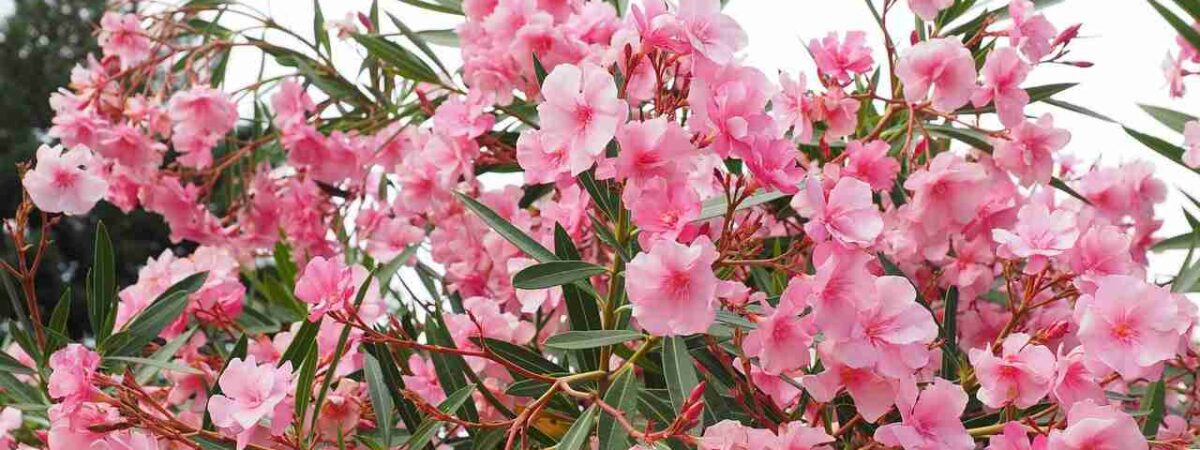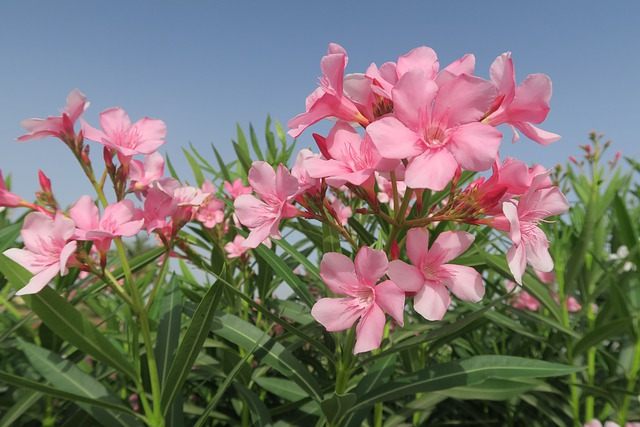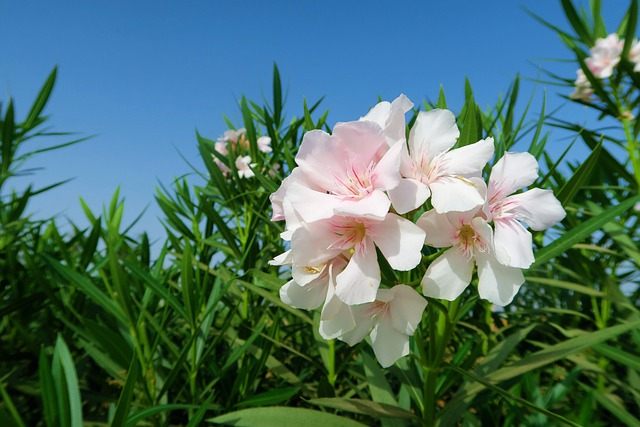A popular and widely used landscape plant in warmer climates, Oleander is grown all around the earth for its carefree habit and attractive star-shaped flowers that add beauty to the garden nearly year-round.
The beauty and tough nature of this evergreen shrub make it commonly visible along highway medians and in public landscapes in different places in California, Florida, and Texas.
Being native to the Mediterranean region, the oleander bush is also well-suited to residential landscapes in various regions, but caution must be taken while planting it due to its toxicity. Here’s how you can safely grow and care for oleander in your yard.
Plant Overview
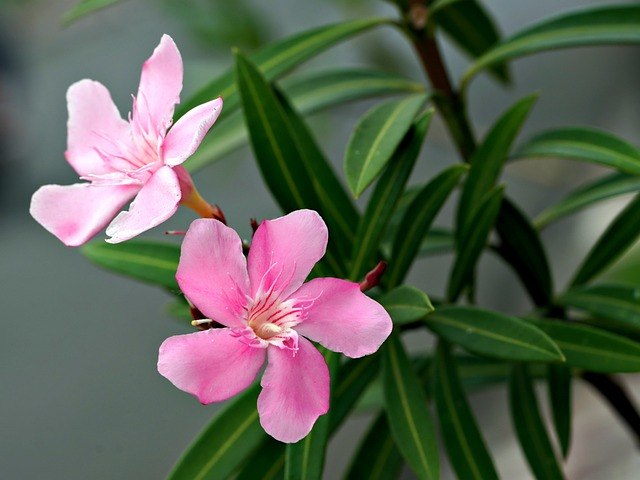
Oleander shrub is a common, attractive, ornamental, and landscaping plant grown worldwide, especially in temperate and subtropical areas. In the wild regions, the plant tends to occur near stream beds in river valleys.
Oleander contains several toxic compounds, which makes it a very poisonous plant. Although the poisonous cases seen are pretty rare, it is suggested to keep your oleander plants away from curious kids or pets.
The sap of the plant may cause irritation and inflammation while ingesting this plant can result in nausea, abdominal pain, and other unpleasant symptoms. So, it is highly suggested to handle your oleander shrub with care and to use protective gloves when you are pruning them or transplanting them.
The foliage of the plant consists of thick, leathery, venations, narrow, lanceolate, dark-green leaves that tend to grow in pairs or whorls of three along with erect, woods, and greyish stems.
The leaves of the plant usually measure from 2 to 8.3 inches in length and 0.4 to 1.4 inches in breadth or diameter.
Oleander varieties to grow
Oleander, scientifically named the Nerium oleander, comes in a wide range of varieties. However, the plants are usually sold by their color rather than their name. The most widely available variants are white, red, and pink flowered forms.
Most of the varieties of oleanders bear plain silvery-green leaves although variegated forms may be found.
The size of the plant is limited by the size of the pot it’s growing in. so it varies according to pot size. As a rough observation, oleanders in pots generally grow in the region of a meter high and 60cm wide, while those oleanders that are planted in the soil of a conservatory or out of doors could grow to approximately 1.5-1.8m high with a slightly narrower spread.
How to plant oleander?
Before planting the oleander, it is necessary to choose the best size where it can be planted. Choose a site that receives full sun to plant your oleander.
Plants can tolerate some shade, but they may become lanky and produce fewer flowers when exposed to less light. As the plant is toxic, avoid planting it around curious children or pets.
Wear protective clothing and gloves while planting to avoid direct contact with the toxic plant. While planting, loosen the soil in your planting area and amend it with compost or some other organic matter. Make sure that the soil where you are planting is well-draining.
Dig a hole in the prepared soil that is 2 to 3 times wider and slightly deeper than the root ball. Remove your plant from the container and tease out its roots if potbound.
Place your plant in the hole so that the top of the root ball can be level with the surrounding soil. Fill in the hole with soil as required, tamp down it gently to remove the air pockets, and water your plant thoroughly.
How to care for oleander?
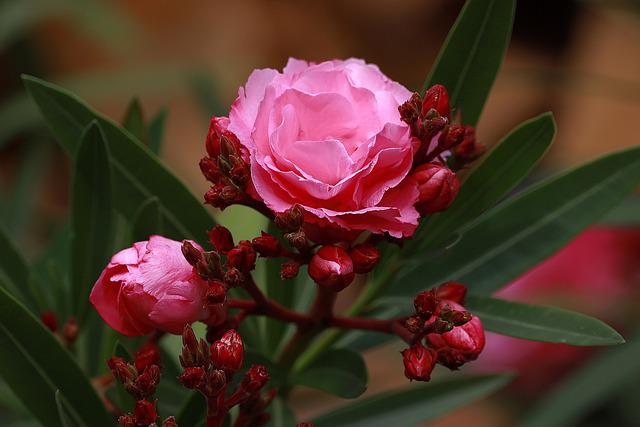
Taking care of the oleander is quite easy. However, they don’t demand any kind of care. Taking the slightest care of this plant can shower you with healthy growth, and abundant bloom.
Light
Oleander prefers to grow in full sun. It can tolerate partial shade, but the foliage of the plant won’t be as dense if it is growing in partial shade. Apart from that, this plant is tolerant of heat, drought, wind, and coastal conditions.
Soil
Oleander needs to thrive in well drained soil. So Plant your shrub in well-drained soil for best results. Oleander shrubs can adapt to many kinds of soil conditions and grow in different types of soil like poor soil, sandy soil, and a range of soil pH levels.
Being Mediterranean plants, oleanders prefer to grow in alkaline soil, but they can also grow in acidic or neutral soil, and adapted to pH levels between 5.0 and 8.3.
So it is recommended to test the pH level of the soil before planting. If your soil is overly acidic, mix some ground limestone, oyster shells, or wood ash into your soil.
Water
Watering the oleander is required whenever the top inch of the soil becomes dry. If you are transplanting container-grown oleander from one pot to another, it is suggested to choose a larger container along with drainage holes to prevent your plant from becoming root-bound.
Fertilizer
Although oleander can grow in poor soil, if you want better growth, you can poor soil with light dose of a balanced fertilizer during the plant’s growing period, especially in the first spring.
Add light fertilization yearly thereafter. Adding another point, established oleanders are not heavy feeders.
Temperature and Humidity
Oleanders are tolerant to light frost and temperatures as low as 20 degrees Fahrenheit. But in the regions where the temperatures reach any lower than that, it is suggested to grow the plant in a container and bring it indoors for winter.
How to propagate oleander shrub?
Oleander can be propagated through cuttings as well as from the seeds. But the easiest and most effective propagation method is propagation through cutting.
It is a very easy aspect of these flowering shrubs that it is very simple to start propagating them from a cutting taken in the early spring, before they start blooming new flowers and after they have generated new growth.
It will take at least a year for the cutting to reach the size where you can plant your plant in the ground or a container.
Here is the method of propagation
Cut a stem from the parent plant that’s six to eight inches long. Make sure that you’re cutting the new growth, and it is necessary to cut just below a leaf node.
Strip the leaves of your cutting until you’re left with three or four on the tip of the stem.
Place the partly stripped cutting in a pot with at least three inches of tap water.
Place the pot in a window with indirect light.
Within a week or two, you will notice that your cutting should sprout roots. At that time, you need to water your plant every two or three days, so you’ll need to water from the pot at least that often.
Once the roots of your plant have reached an inch to two inches long, pot your plant in a six-inch container that is filled with well-draining soil.
Place the container where it can get direct sunlight as It will need at least four hours of direct or indirect sunlight per day to grow.
Common pests and Diseases
Oleander is prone to be attacked by an oleander caterpillar, Syntomeida epilais, to contend with, though, and this bug didn’t get its name accidentally: It is the main pest that causes harm to this shrub.
The larvae can devastate the young shoots of the plant, and if you spot only skeletal remains of foliage, there’s a good chance to know that your plant is infested with these pests.The mature oleander caterpillars are a sight to behold. In other words, they are fuzzy, rust-red crawlers sprouting black tufts.
Apart from this insect, oleander is also susceptible to less likely pests, which include aphids, mealybugs, and scale insects.
Usually, if you spot these larvae scraped the leaves, then cut the foliage they’re feeding on, and get rid of them in the process.
Otherwise, if you spot the mature ones, you can easily pick them off by hand.
The oleanders are hardy and can thrive if neglected. Just check out if they are infected by the insects and take proper care of them.ConclusionStrong, attractive, low-maintenance
A popular and widely used landscape plant in warmer climates, Oleander is grown all around the earth for its carefree habit and attractive star-shaped flowers that add beauty to the garden nearly year-round.
The beauty and tough nature of this evergreen shrub make it commonly visible along highway medians and in public landscapes in different places in California, Florida, and Texas.
Being native to the Mediterranean region, the oleander bush is also well-suited to residential landscapes in various regions, but caution must be taken while planting it due to its toxicity. Here’s how you can safely grow and care for oleander in your yard.
Conclusion
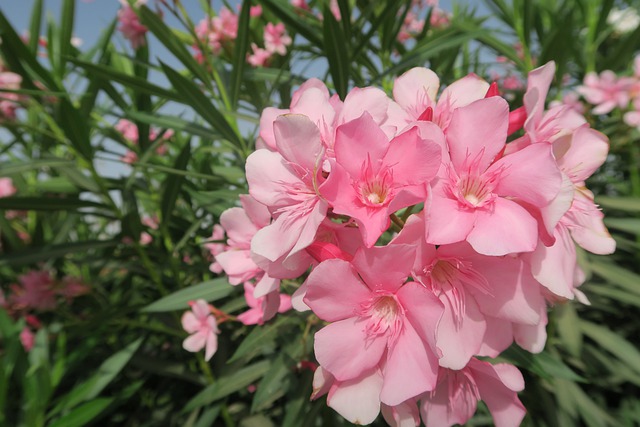
Strong, attractive, low-maintenance, and one-of-a-kind beauty – these are the words that can perfectly describe Oleander at its very best. The independent nature of the oleander makes it truly irresistible and a must-have in every plant collection and every yard.
The best part of keeping this beauty at home or garden is that this rich shrub produces sweet fragrant and abundant blooms that you can enjoy all year round.
So what are you waiting for?
Bring this abundant beauty to your home and let us know how it is going.
You may also like to read
How to grow and care for Mahonia – From planting to propagation

